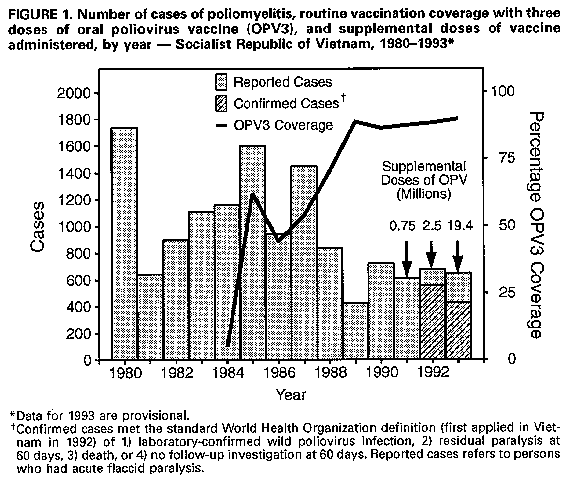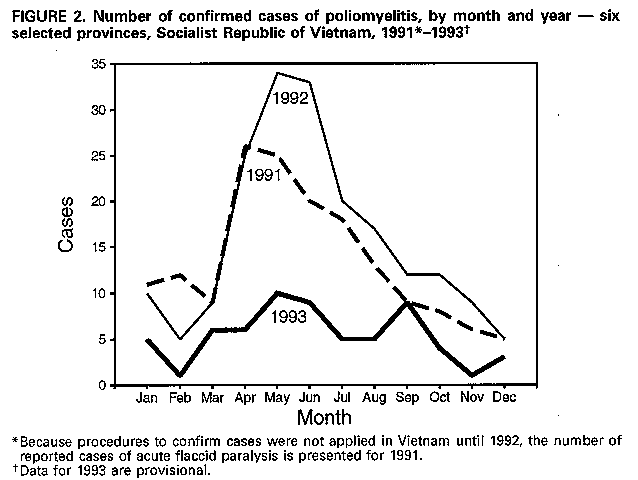 |
|
|
|
|
|
|
|
|
|
|
|
|
|
|
|
|
||||
| ||||||||||
|
|
|
|
Progress Toward Poliomyelitis Eradication -- Socialist Republic of Vietnam, 1991-1993In 1988, the World Health Organization (WHO) established the goal of global eradication of poliomyelitis by the year 2000 (1), and the Western Pacific Region (WPR) of WHO established the goal of regional eradication by 1995 (2). In 1990, the Socialist Republic of Vietnam (1993 population: 70.9 million; approximately 2 million births annually) endorsed this regional goal and enacted a National Plan of Action for eradication. This plan comprises three main strategies: 1) maintenance of high coverage with three doses of oral poliovirus vaccine (OPV) through routine vaccination; 2) supplemental vaccination with OPV, including National Immunization Days (NIDs) and outbreak-response vaccination; and 3) surveillance of acute flaccid paralysis (AFP) cases. This report summarizes the polio eradication effort in Vietnam during 1991-1993. Vaccination coverage of children aged less than 1 year who received three doses of OPV was 88.6% in 1992 and 90.1% in 1993, based on routine monthly reports of doses administered. These monthly reports may have overestimated true coverage because vaccination coverage surveys in April 1992 in six of 53 provinces (Dac Lac, Hanoi, Kien Giang, Nghe An, Quang Binh, and Song Be) estimated that coverage with three doses of OPV was 0-16% lower than reported by the doses-administered method. During October-November 1991, supplemental OPV activities in selected areas of Vietnam resulted in the vaccination of 375,000 children aged less than 3 years in Hanoi and Ho Chi Minh City with two doses each of OPV. During October-November 1992, 1.25 million children aged less than 3 years received one dose of OPV in each of two separate vaccination rounds during Provincial Immunization Days in Hanoi, Ho Chi Minh City, and six provinces (Binh Dinh, Can Tho, Dong Nai, Hai Hung, Nam Ha, and Tien Giang). The first NIDs were conducted during November-December 1993 and enabled administration of two doses of OPV to 9.7 million children (85%-90% of vaccinated children were aged less than 5 years) (Figure_1); estimated coverage of children aged less than 5 years was 83%-88%. Vaccines were delivered from fixed sites or by outreach teams. In addition to OPV, all children aged 6-59 months received one dose of vitamin A; 202,000 children aged 9-23 months in selected areas received measles vaccine; and 1.1 million women of childbearing age each received two doses of tetanus toxoid. The NIDs involved participation of 200,000 volunteers in 10,000 communes, 30,000 health workers, national political leaders, local governments, community organizations, religious leaders, medical staff, police officers, military personnel, and teachers. In the 1-2 weeks before the NIDs, lists of eligible children were compiled in most provinces and letters of appointment issued to parents during house-to-house visits by health workers. The NIDs were preceded by intensive mass media publicity, including daily national and local television and radio broadcasts, newspaper reports, posters, and loudspeaker announcements. The central and provincial governments contributed approximately $1.2 million for campaign activities. Vaccines were supplied by Rotary International, the United Nations Children's Fund, the Australian International Development Assistance Bureau, the Japan International Cooperation Agency, the Canadian International Development Agency, SmithKline Beecham Biologicals * (Rixensart, Belgium), and Pasteur-Merieux Serums and Vaccines (Lyon, France). In 1992, 677 cases of AFP were reported in 42 (79%) of 53 provinces and in 184 (33%) of 552 districts; 557 cases were confirmed as polio based on standard WHO criteria. In 1993, the number of reported cases of AFP decreased to 641; of these, 425 were confirmed as polio (including 75 by type 1 wild poliovirus isolation) (provisional data). During 1993, there was no characteristic summertime seasonal increase in confirmed polio cases in the six provinces where 1992 Provincial Immunization Days were conducted (Figure_2). Reported by: Le D Hong, MD, Nguyen V Bien, MD, Trinh Q Huan, MD, Cao V Hoa, MD, Dang X Khoat, MD, Tran V Hung, MD, Tran V Hieu, Expanded Program on Immunization, Ministry of Health, Hanoi; Hoang T Nguyen, MD, Nguyen V Man, MD, Tran V Tien, MD, Nguyen T Yen, MD, Thanh K Dung, MD, Doan N Anh, PhD, Pham TN Oanh, National Institute of Hygiene and Epidemiology, Hanoi; Le D Hinh, MD, Bach Mai Hospital, Hanoi; Doan T Tam, MD, National Center for Vaccine Quality Control, Hanoi; Ha B Khiem, MD, Pham K Sac, MD, Nguyen TT Thuy, MD, Van TT Binh, MD, Nguyen M Phuong, MD, Phan V Tu, MD, Nguyen T Long, MD, Pasteur Institute, Ho Chi Minh City; Vo C Khanh, MD, Center for Tropical Diseases, Ho Chi Minh City; Nguyen TT Tram, MD, Pasteur Institute, Nha Trang; Nguyen A Phuong, MD, Institute of Hygiene and Epidemiology, Tay Nguyen, Socialist Republic of Vietnam. Expanded Program on Immunization Unit, Western Pacific Regional Office, World Health Organization, Manila, Philippines. Expanded Program on Immunization, Global Program for Vaccines, World Health Organization Headquarters, Geneva. Div of Viral and Rickettsial Diseases, National Center for Infectious Diseases; Polio Eradication Activity, National Immunization Program, CDC. Editorial NoteEditorial Note: Among member countries of the WPR, Vietnam had the second highest reported incidence of polio in 1992 and 1993 (after Cambodia), resulting in 557 (29%) of the 1912 confirmed cases reported in the WPR in 1992 and 425 (35%) of the 1228 confirmed cases reported in 1993 (provisional data). Although the increased OPV coverage through routine vaccination has resulted in a substantial decrease in the incidence of polio in Vietnam, supplemental vaccination activities are warranted for three reasons: 1) routine vaccination with three OPV doses has not been successful in interrupting wild poliovirus transmission in most countries with endemic polio; 2) outbreaks of polio in Vietnam could occur following the accumulation of susceptible persons during years of reduced incidence; and 3) NIDs that deliver two OPV doses at 1-2-month intervals to all children aged less than 5 years have been successful in interrupting wild poliovirus transmission in the Western Hemisphere (3). The decrease in the number of reported AFP cases in Vietnam in 1993 primarily reflects a decrease in reported cases in the six provinces in which immunization days were conducted for children aged less than 3 years in 1992. This pattern is consistent with findings in China that, under certain circumstances, supplemental OPV vaccination targeting children aged less than 3 or less than 4 years, rather than less than 5 years, may be sufficient to reduce or interrupt wild poliovirus transmission. The incidence of polio in Vietnam has been highest in the southern provinces of the Mekong Delta region, which border provinces in Cambodia where the incidence is also high. Preliminary genotype studies indicate that type 1 polioviruses circulating in the Mekong Delta region of southern Vietnam and Cambodia are closely related and represent a common virus reservoir; isolates from northern Vietnam constitute a separate reservoir (CDC, unpublished data, 1993). Because population movement across the border is extensive, supplemental vaccination activities in Cambodia will be critical to reduce the risk of cross-border importations and to interrupt wild poliovirus circulation in the WPR. The apparent elimination of wild poliovirus infections in the Americas and the substantial progress in the WPR demonstrate the feasibility of achieving eradication in WPR and other regions of the world (4). Each of the five countries with endemic polio in the WPR have adopted the 1995 eradication goal and are conducting or planning to conduct NIDs in 1994 and 1995 (5,6). The success of the first NIDs in Vietnam resulted from the combination of strong political and financial commitment from the highest levels of government, a successful social mobilization and information campaign, and coordination among donor agencies to supply adequate quantities of vaccine. References
* Use of trade names and commercial sources is for identification only and does not imply endorsement by the Public Health Service or the U.S. Department of Health and Human Services. Figure_1  Return to top. Figure_2  Return to top. Disclaimer All MMWR HTML versions of articles are electronic conversions from ASCII text into HTML. This conversion may have resulted in character translation or format errors in the HTML version. Users should not rely on this HTML document, but are referred to the electronic PDF version and/or the original MMWR paper copy for the official text, figures, and tables. An original paper copy of this issue can be obtained from the Superintendent of Documents, U.S. Government Printing Office (GPO), Washington, DC 20402-9371; telephone: (202) 512-1800. Contact GPO for current prices. **Questions or messages regarding errors in formatting should be addressed to mmwrq@cdc.gov.Page converted: 09/19/98 |
|||||||||
This page last reviewed 5/2/01
|